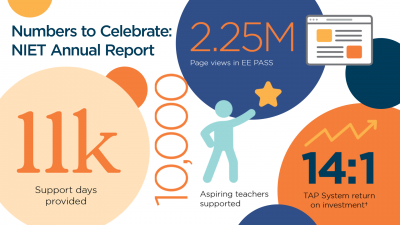Leadership Is a Disposition, Not a Position
Donaldsonville, LA | 2019

The Scene
Ascension Public Schools, located between New Orleans and Baton Rouge, is currently an A district on the state school rating system and the number two district in the state in terms of academic achievement. This wasn’t always the case.
Fifteen years ago, Ascension faced a persistent achievement gap between its high-poverty, high-minority schools and more affluent schools in the district. Ascension’s school improvement plan for its lowest-achieving schools moved all of them up at least one letter grade, with several schools achieving a B rating.
What enabled these schools to more rapidly improve was an investment in intensive support for classroom teacher instructional improvement through a partnership with NIET.
The Challenge
The district spans 300 square miles, and serves 22,500 students in 27 schools. Forty-eight percent of Ascension students are economically disadvantaged, and 42% are minority students.
High-need students are heavily concentrated in a small number of schools that were historically rated as D or F schools. Ascension has worked to improve student academic outcomes through a variety of strategies over the last 15 years, with an intensive focus on building the skills of classroom teachers who serve students with the greatest barriers to learning.
The New Approach
In the 2005-06 school year, district leaders partnered with NIET to support two high-need schools that had been identified by the state as needing improvement. The strategy focused on intensive support for classroom instruction through the elements of NIET's TAP System for Teacher and Student Advancement (TAP). TAP's core strategy is to train teacher leaders and school leaders to provide instructional support for classroom teachers through school-based professional learning and coaching.
Teacher leaders were trained to observe and coach classroom teachers, and to lead weekly collaborative learning teams. As leaders of weekly learning teams, teacher leaders supported their colleagues to analyze student data, identify and apply effective student strategies and continuously improve their instructional techniques.
As principals and teacher leaders developed their own skills, and better supported the development of classroom teachers, student achievement began to increase.
Success in the initial two schools led district leaders to expand the work to 14 of its highest-need schools (deemed Turnaround Zone schools).
The Results
The comprehensive approach led to a shared vision of great teaching, better recruitment and retention of highly effective teachers to high-need schools, expanded learning opportunities for educators, alignment between district- and school-level learning, and better use of data to plan and promote equitable access.
Under the leadership of Superintendent David Alexander, Ascension continues to support increased growth in its highest-need schools. In 2018, Ascension ranked second in the state in the percentage of students scoring Mastery and Advanced on the grades 3-8 state assessments.
Investments in people created a structure of support that is an engine for continuous improvement. Ascension Public Schools strengthened school culture and drew talent to its highest-need schools. Successful innovations impacted schools across the district, raising achievement levels for all students.



